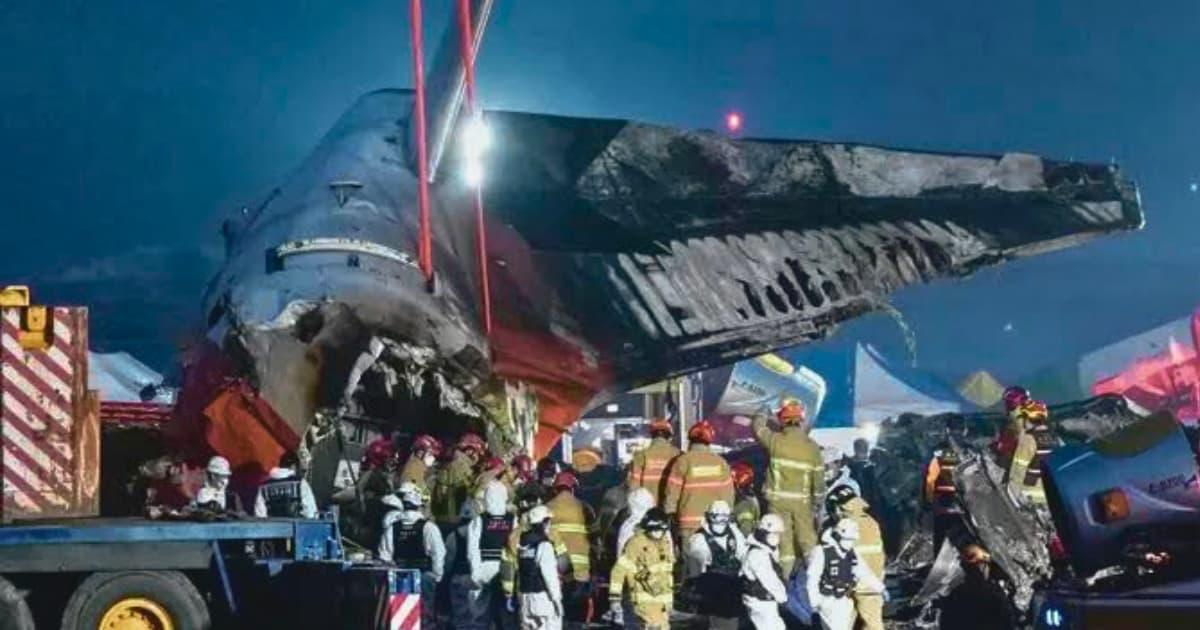
Bird Strike, Gear Glitch, Belly Landing: What Led To South Korea Plane Crash that claimed 179 lives
The tragic crash of a Jeju Air Boeing 737-800 at Muan International Airport in South Korea has claimed 179 lives. The aircraft, carrying 181 passengers, attempted a belly landing after a suspected bird strike caused a malfunction in its landing gear. Moments before the crash, the plane was seen dragging along the runway on its underbody before slamming into a wall and erupting in flames.
What Happened?
According to initial reports, the flight encountered difficulties as it approached Muan International Airport. A Yonhap News Agency report, quoting airport officials, revealed that the pilot attempted a crash landing after failing a regular landing. Witnesses and preliminary investigations indicate that the landing gear did not deploy, forcing the crew to resort to a belly landing—a high-risk maneuver.
The suspected cause of the malfunction is a bird strike, which occurs when birds collide with an aircraft, potentially damaging critical systems. Muan Fire Station Chief Lee Jeong-hyun confirmed that bad weather may have compounded the situation. “The cause of the accident is presumed to be a bird strike combined with adverse weather conditions. However, the exact cause will be announced following a joint investigation,” he said.
A Sequence of Failures
Videos of the crash show the plane dragging on its belly along the runway, sparks flying, before crashing into a barrier at high speed and bursting into flames. This has raised several critical questions about the sequence of events leading to the disaster.
One key point of contention is the plane’s speed during the landing attempt. Social media users, including aviation experts, noted that the Boeing 737-800 was moving unusually fast for a runway less than three kilometers long. Others questioned why emergency responders, such as firefighters, were not positioned near the runway, as is common protocol for an emergency landing.
Additionally, the flight path indicates the aircraft did not circle the airport before attempting the belly landing. This is unusual, as pilots dealing with technical issues typically circle the area to troubleshoot and burn excess fuel.
The Maneuver: Belly Landing
A belly landing, also known as a gear-up landing, is a last-resort procedure when the landing gear cannot be deployed. It involves landing the aircraft on its underbody, which is not designed to bear the full impact of a landing. While risky, it can be a life-saving maneuver when executed correctly.
In this case, the absence of visible preparation, such as circling or reducing speed, may have exacerbated the severity of the crash. Experts believe that adverse weather conditions and the bird strike could have further impaired the crew’s ability to manage the emergency effectively.
Understanding Bird Strikes and Gear Glitches
A bird strike occurs when birds collide with an aircraft during flight. Such collisions are most common during takeoff and landing when planes fly at lower altitudes. While modern aircraft are designed to withstand minor bird strikes, large birds or a collision involving multiple birds can damage engines, sensors, or landing gear.
A gear glitch refers to a malfunction in the landing gear system, preventing the wheels from deploying. This can result from mechanical failure, hydraulic issues, or external factors such as debris or a bird strike. Pilots are trained to handle such scenarios, but the outcome depends on several variables, including weather, runway conditions, and the aircraft’s speed.
The Aftermath and Investigations
Jeju Air, a low-cost carrier and one of South Korea’s leading airlines, issued a public apology. “We at Jeju Air will do everything in our power in response to this accident. We sincerely apologise for causing concern,” the airline stated.
Rescue operations have been underway, but only two survivors have been pulled from the wreckage so far. Authorities fear the death toll will rise as recovery efforts continue.
A joint investigation involving aviation experts, the South Korean government, and international authorities is set to begin. The inquiry will focus on the suspected bird strike, the apparent landing gear failure, and the pilot’s decision-making during the emergency.
Lessons to Learn
This tragic incident has highlighted several critical issues in aviation safety. It underscores the importance of bird-strike mitigation strategies, such as improved airport wildlife management and advanced radar systems to detect bird activity.
Additionally, the accident raises questions about emergency preparedness at airports. If the belly landing was anticipated, why were emergency responders not stationed near the runway? Finally, the speed and trajectory of the plane during its landing attempt suggest a need for clearer protocols when dealing with such emergencies.
Awadh360 plus
As the world mourns the victims of this devastating crash, the aviation industry must scrutinise every aspect of the incident to prevent similar tragedies. Bird strikes and mechanical malfunctions are not uncommon, but their combination, compounded by poor weather, turned this situation catastrophic. While Jeju Air and investigators work to uncover the exact sequence of events, the focus must remain on supporting the victims’ families and improving aviation safety for the future.
Popular Categories
Read More Articles
Business
D2C plant-based nutrition brand Earthful is hiring Moms to Speak on Menopause & is offering ₹1 Lakh Stipend! by Awadh 360° Desk December 15, 2025India
Appropriation vs. Appreciation: Reclaiming Indian Culture, Craft and Credit by Mohammed M. Raza December 13, 2025Politics
BJP turns to OBC leader Pankaj Chaudhary for UP top post by Awadh 360° Desk December 13, 2025Business
KGMU, Aditya Birla Capital Inaugurate State-of-the-Art BMT Ward to Transform Cancer Care in Uttar Pradesh by Awadh 360° Desk December 12, 2025



